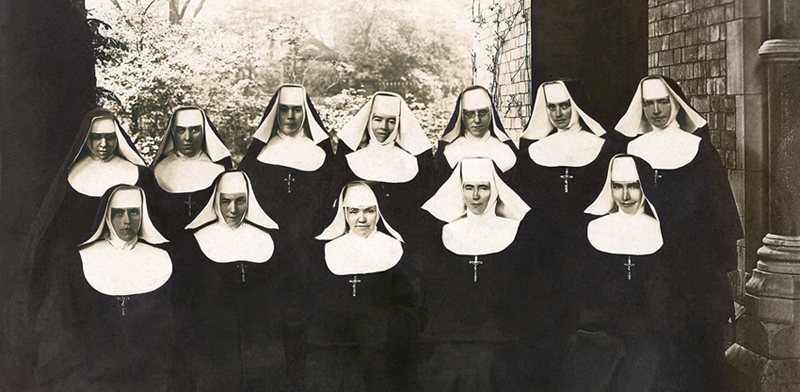History and Roots: Stick to Your Colours
by Susan Francois, CSJP
In our Congregation archives, we have the final advice of Mother Evangelista (Honoria Gaffney) to the assembled community of sisters in Nottingham from her deathbed, as recorded by Sister Ignatius Killian:
“Stick to your colours. Uphold the simplicity, unity, and family spirit that have always animated and been the distinctive character of our Community. Mother Clare taught it to us. Mother Teresa Kiernan received it and taught it. I in my poor way have done my best to uphold it. Trust and have confidence in one another, as the spouses and dear children of Jesus Christ. Be kind to one another.”
These words ring true to her lived experience as a Sister of St. Joseph of Peace, from the beginning of her vocational call to her very last breath.
As one of the first sisters to profess vows, who just four years later was thrust into a leadership position as the first Superior General, Mother Evangelista experienced firsthand the challenging early years of the Congregation. She described these times in response to the questions of Bishop Dunn of Nottingham, a few months before her death: “We have had poverty, humiliations, trials, difficulties, disappointments, failures, etc. but never a moments’ regret for having entered religion with Rev. Mother Clare.” From the perspective of history, her instincts and experience seem to have helped her to know and teach that, when faced with times of struggle and uncertainty, the mission of peace is best served by simply being who we say we are.
Although Mother Evangelista did not leave a vast written repository like her companion Mother Clare, her few written reflections and letters found in our archives paint a picture of a deeply spiritual woman rooted in the love and peace of God. As a thirty-year-old teacher discerning a religious vocation, she was struck “very forcibly” by a remark of a Dominican Father while on retreat: “If you give your heart to God don’t divide it.” Unity and a desire for an undivided heart guided her way of being, thinking, and acting throughout her life, and especially in her ministry of leadership. (The Undivided Heart is the title of the 1958 biography of Mother Evangelista by Sister Rosarrii McDermott.)
As formation director, she encouraged the sisters to “aim at striking deep roots” early in their religious life, going so far as to take the postulants to the potting house for a practical demonstration, where the gardener had sown seedlings. Sister Stanislaus, one of the postulants, later reflected that in time “good sturdy plants appeared—a good lesson and an inspiring one at the beginning of one’s postulancy.” One of Evangelista’s novices, Sister Loyola, remembered her “outstanding virtues—humility and love of God in the person of all those she met each day, an abiding knowledge of the Presence of God.”
Not only did Mother Evangelista plant seeds of peace in the young women she guided on their discernment journey, the retreat notes that she left us also clearly demonstrate her commitment to nourishing her own deep roots through prayer and regular retreats. In her notes, she often reflected on the presence of God. “Empty yourself of yourself, and you will find God. God and me and Jesus. God is all.” These roots enabled Mother Evangelista to resist division and negative forces by holding fast to her belief in the abiding presence of a God who calls us to unity.
In 1896, just over a decade after our founding, and several years after the tumultuous departure of Mother Clare in 1888, the Congregation counted 71 members in three separate dioceses across a vast geographic spread: 22 in the Diocese of Nottingham, 8 in the Nisqually Diocese (now Seattle), and 41 in the Diocese of Newark. Looking back from the perspective of our era of digital communication and global travel, it is hard to imagine how Mother Evangelista and her leadership council fostered unity and connection across the miles.
Nevertheless, she firmly believed in the family spirit and unity of the Congregation, even when pressured by Bishop Wigger of Newark to divide the Congregation in the United States from that in England. The Bishop had refused to approve the profession of vows of sisters in his diocese until the matter was resolved. This understandably caused Mother Evangelista much anxiety.
With the support of Bishop Bagshawe of Nottingham, Mother Evangelista wrote to Rome: “We feel convinced that to sever this connection would be to the detriment of the communities on both sides and would only destroy the spirit of unity and harmony which exists throughout. … All I seek is to protect the interests of our Institute by keeping them as one body and one head for the accomplishment of the greater good.” Her letter makes a clear argument and plea for the support of the Sacred Congregation. “If one separation takes place another will most likely follow.”
True to her oft quoted adage to the sisters to “be kind to God’s priests and God’s poor,” she also makes a distinct effort to be respectful of Bishop Wigger in the letter to Rome. “The Rt. Rev. Bishop of Newark has largely contributed to the success which has attended the works of our Sisters in America and we owe in return a lifelong debt of gratitude.” In other words, even in the face of the possible destruction of the community, she stuck to our colours and acted as a woman of peace.
Thankfully, the Sacred Congregation in Rome sided with Mother Evangelista and Bishop Bagshawe. We remained then, as we are today, one Congregation united in our diversity across three distinct geographic regions.
This article appeared in the Autumn 2023 issue of Living Peace.

